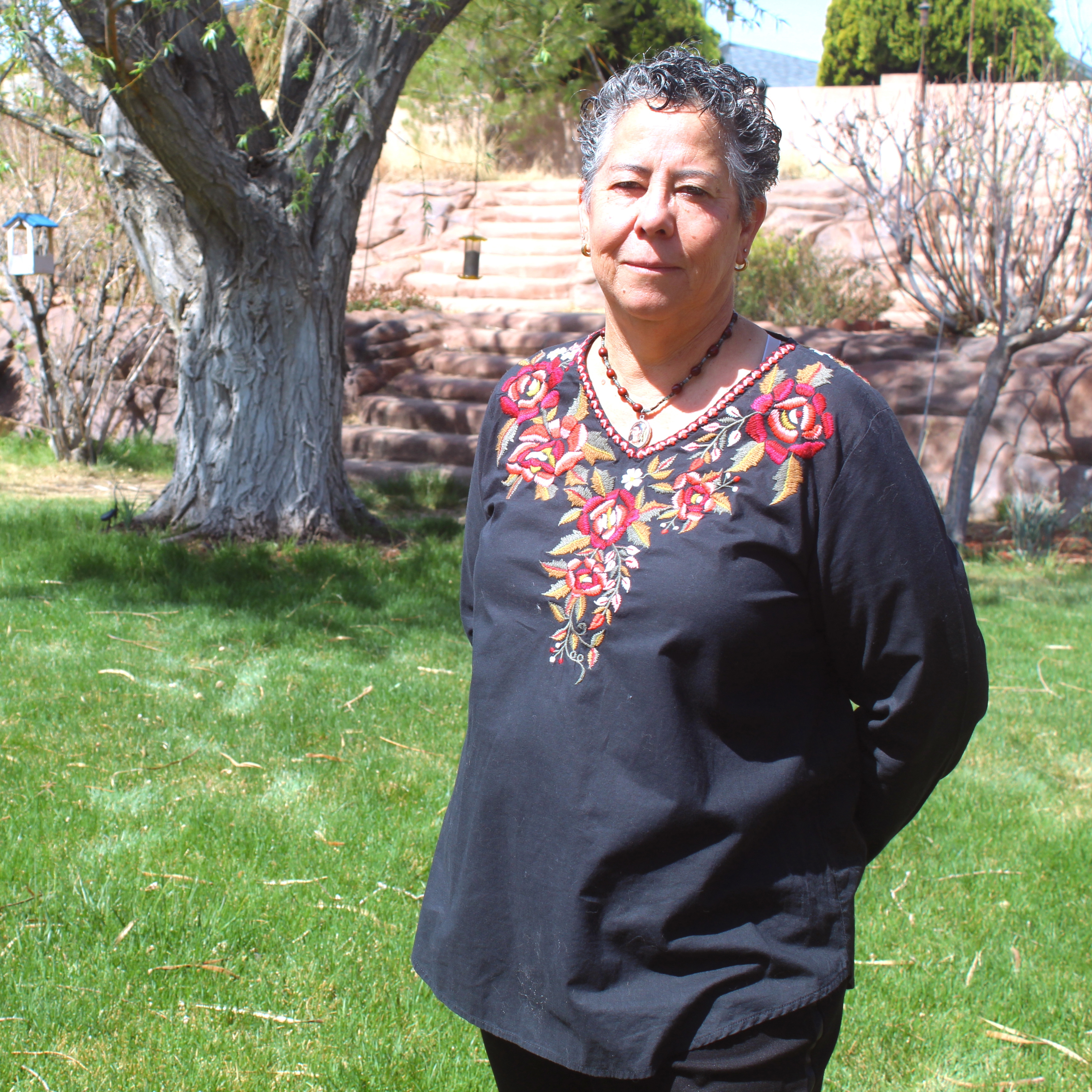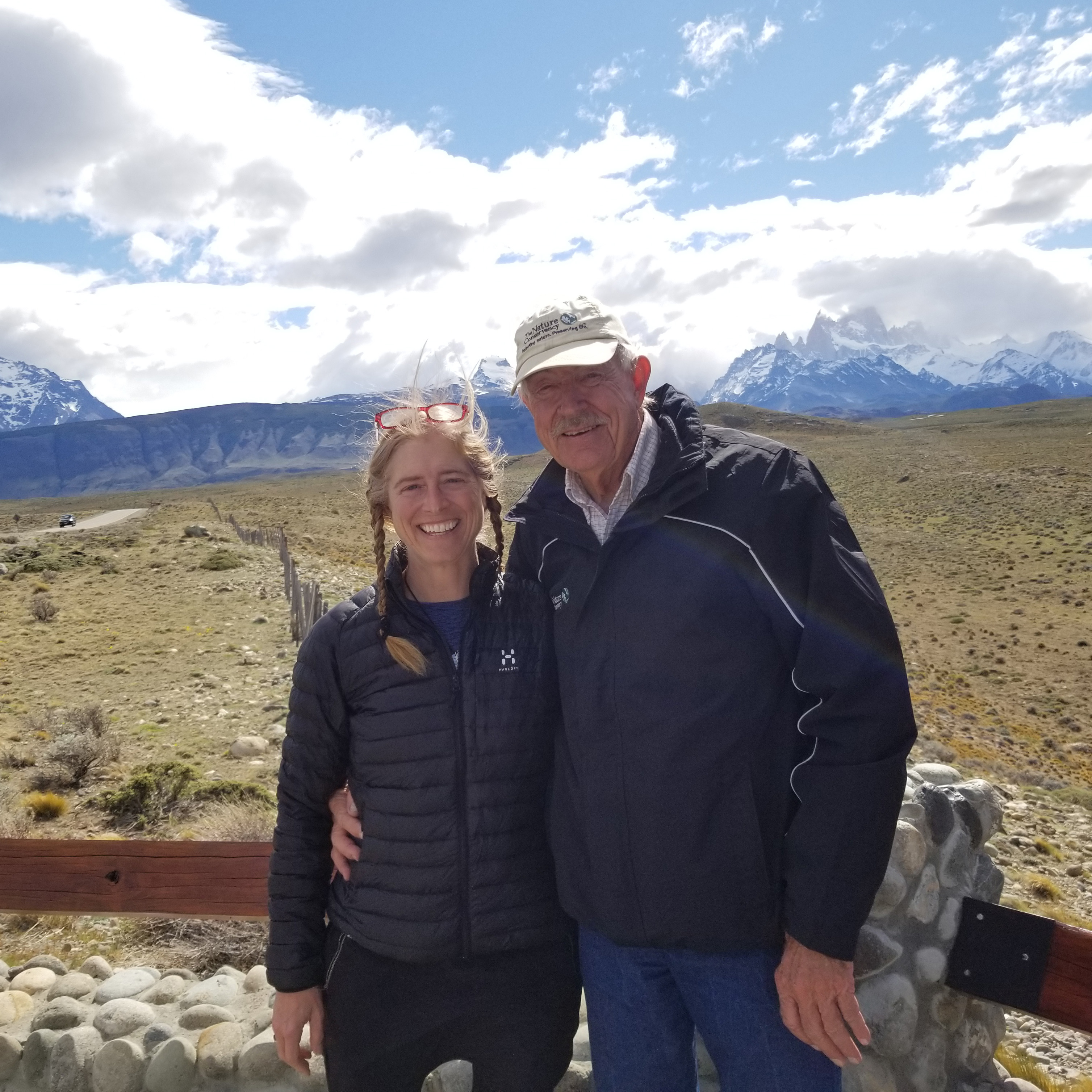Learn More
Status of Medical aid in dying
Medical aid in dying is authorized in New Mexico. Currently, the state Legislature is considering clarifications to the existing law. On March 15, 2023, the House floor heard the Third Reading of SB 471, and it unanimously passed (66-0). The law was signed by Governor Lujan Grisham (D).
Learn More
Take Action
- Attend an event in New Mexico: Participate in virtual activities related to medical aid in dying and advance care planning.
- Learn about End of Life Options New Mexico
- Volunteer With Us: Join other passionate and dedicated individuals to work to re-enact legislation that improves care and expands end-of-life choice.
- Request a Presentation: We’ll explain the full range of end-of-life options and explain step-by-step how the law works – in English and in Spanish.
- Follow Compassion & Choices New Mexico on Facebook
Bilingual Access Campaign
- Helps patients, caregivers and health professionals understand how the law works.
- Assists healthcare facilities develop more supportive policies.
- Provides technical assistance and presentations to healthcare providers on end-of-life options.
Tools and Resources
 For Patients Learn whether you are eligible for the New Mexico Elizabeth Whitefield End-of-Life Options Act.
You can click here to access the New Mexico advance directive.
For Patients Learn whether you are eligible for the New Mexico Elizabeth Whitefield End-of-Life Options Act.
You can click here to access the New Mexico advance directive.
 End-of-Life Planning Use our step-by-step guide to chart your journey.
End-of-Life Planning Use our step-by-step guide to chart your journey.
 Los recursos en Español Los recursos en Español.
Los recursos en Español Los recursos en Español.
 COVID-19 Toolkit Get answers to your questions about COVID-19
and end of life care.
COVID-19 Toolkit Get answers to your questions about COVID-19
and end of life care.
 Resources for Providers Find resources tailored to the needs
of healthcare providers.
Resources for Providers Find resources tailored to the needs
of healthcare providers.
History
Compassion & Choices, the Compassion & Choices Action Network and the New Mexico End-of-Life Options Coalition made history with the passage of the Elizabeth Whitefield End of Life Options Act. Despite the alarming and swift onset of COVID-19, or perhaps because of it, lawmakers followed the desires of the majority of New Mexico residents by supporting legislation to give eligible terminally ill adults the option of medical aid in dying.
The Beginning
Our efforts to bring medical aid in dying to terminally ill residents of New Mexico began in 2012 with a court case (Morris V. Bradenburg) involving two physicians, Dr. Katherine Morris and Dr. Aroop Mangalik, and their patient, Aja Riggs. Together with the ACLU of New Mexico we sought to clarify the ability of mentally capable, terminally ill patients to obtain aid in dying from their physician if they find their dying process unbearable.
After an initial favorable decision in the district court, in 2016, the end-of-life autonomy movement received a crushing blow when the New Mexico Supreme Court unanimously ruled that it was the role of the legislature, not the courts, to decide ways in which the state would allow physicians to end patients suffering.
Supreme Court Justice Charles Daniels joined in the 2016 unanimous ruling against the end of life option. Yet he personally believed that every terminally ill person should have the right to decide when to die.
During the last week of his life with ALS, he was suffering, gasping for breath, and ready to be gone. His doctors were not allowed to help him.
His wife, Randi McGinn, said this year “It is time for the New Mexico Legislature to pass HB 47, the Elizabeth Whitefield End-of-Life Options Act, so no other good men and women have to suffer in the same way. Since the mortality rate for human beings is 100%, it is an option that every one of us should have at the end of our lives.”
The Path Forward
Through the court case and grassroots organizing a formidable coalition of organizations and individuals that support end of life autonomy had formed. Thus, in 2016, Compassion & Choices, working in collaboration with local leaders, established the New Mexico End-of-Life Options Coalition.
Together, we launched a robust multifaceted campaign; Compassion & Choices and the Compassion & Choices Action Network funded an on-the-ground organizer, lobbying team and communications staff. Together, along with our volunteers and action teams and members of the New Mexico End of Life Options Coalition, we organized hearings, conducted paid, earned and social media; and inspired strong and robust grassroots efforts. Volunteer advocates shared their stories and support through emails, phone calls, lobby days, social media, videos, and a collection of stories in our storybook.
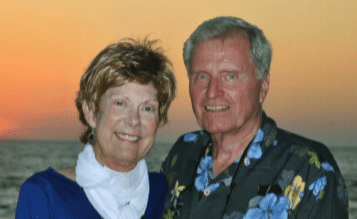
Judge Elizabeth Whitefield, for which the bill was named, and her husband.
In 2017 Representatives Deborah Armstrong and Bill McCamley carried HB 171 and Senator Liz Stefanics carried SB 252, respectively. Despite the monumental efforts of nearly 6,000 Compassion & Choices supporters and citizen advocates from across the state, the 2017 New Mexico End of Life Options Act was narrowly defeated on the Senate floor by a 22-20 vote.
Over the next few years, the New Mexico End of Life Options Coalition, Compassion & Choices and the Compassion & Choices Action Network were unstoppable, passing three municipal resolutions in support of medical aid in dying, securing endorsements from a myriad of local organizations, conducting an Ask the Candidate program, presenting to medical groups and the public, identifying storytellers to put a human face on the issue and so much more. In addition, New Mexico’s rural outreach team presented to bilingual members of the Community Health Worker Association and has offered continuing education units in three different rural communities.
While the public campaign was front-and center, behind the scenes the bill sponsor and local legal experts were carefully drafting a bill, which we reviewed and provided input on throughout the way, that recognized that a more appropriate balance
between safeguards and access was needed. This bill included key provisions, such as: 1) allowing advanced practice registered nurses and physician assistants to prescribe, 2) reducing the 15-day waiting period to 48 hours; and 3) requiring just one
physician to certify eligibility if the person is already enrolled in hospice care. When this bill was introduced in January of 2019 it represented a turning point in the movement; it was the first time that state lawmakers were willing to acknowledge
that the problem with the Oregon model legislation was not that there were not enough safeguards, but rather that there were too many unnecessary barriers. Unfortunately, the 2019 session ended without sufficient time to pass the bill.
The Final Stretch
With years of public education, grassroots organizing and lobbying behind us, we came into the 2021 session in a strong position, knowing that this very well could be the year terminally ill residents of New Mexico’s voice was finally heard. However, the 2021 legislative session looked quite different; lawmakers were focused on the COVID-19 pandemic and all hearings were conducted virtually to minimize risk of the virus.
We quickly adapted our approach to account for the new reality and took our campaign virtual, using the power of our storytellers (see New Mexico Storybook) to put a human face on the issue. We flooded news outlets with story after story that demonstrated the importance of passing medical aid in dying legislation this session. Here are a few examples:
- Benanav, Michael. SearchLight New Mexico, Last Rights. Legalizing the decision to end one’s life
- Distasio, Maya. Albuquerque Journal, Grandpa Vince should have died peacefully, not violently
- Editorial Board, Albuquerque Journal, Editorial: Aid-in-dying bill brings peace of mind, dignity to final days
- Huerta, Dolores. Albuquerque Journal, New Mexico needs end-of-life care options now
- Otero, Jorge. Santa Fe, New Mexican, My father suffered; others should not have to
- Public News Service, End-of-Life Options Act’ Heads to New Mexico Senate
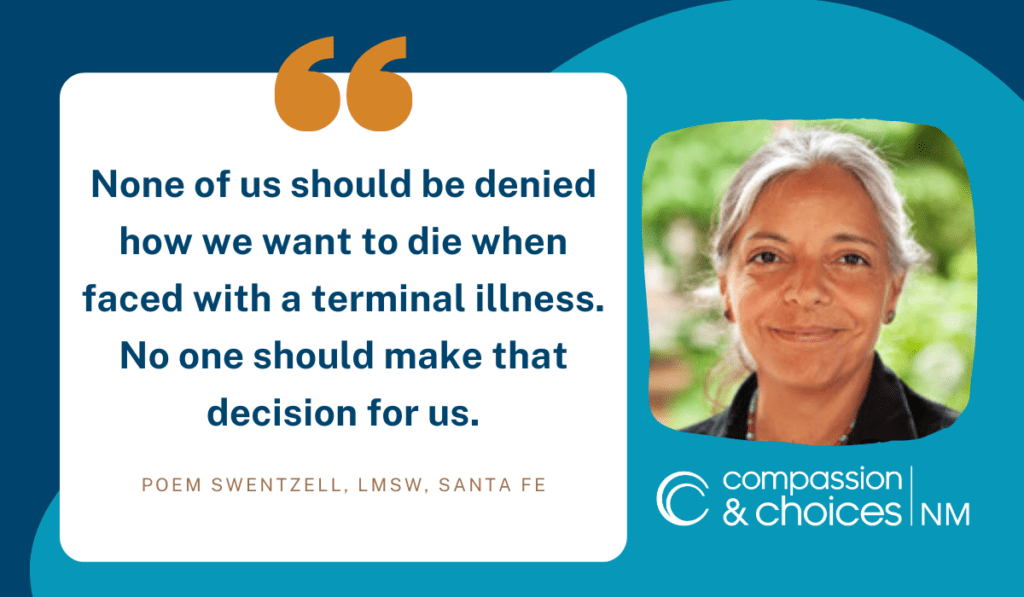
One of the most difficult challenges was that with the virtual hearings. Testifiers were only allowed 1-2 minutes time to deliver their messages. This required the careful selection of the right mix of testifiers and incredible restraint on behalf of the testifiers to stick to a very narrow time limit. Our 16 testifiers in the first hearing could not have done a better job.
These public, visible efforts to change hearts and minds worked in partnership with behind the scenes efforts to garner the needed votes to get the bill heard and passed out of four committees, voted through two floor votes and ultimately to the governor’s desk. The bill sponsors along with expert leaders from the local coalition, along with the support of our local team, led efforts to secure endorsements and negotiate bill language that ultimately garnered impressive victories in both the house and senate.
With each step we organized we gained strength. It started with a very short 60-day session. We moved quickly through two committees in both the House and Senate, followed by floor votes. The chart below shows the strong support for this bill among all committee members. It all paid off when, during the last week of the session, lawmakers gave New Mexico residents the medical option of aid in dying.
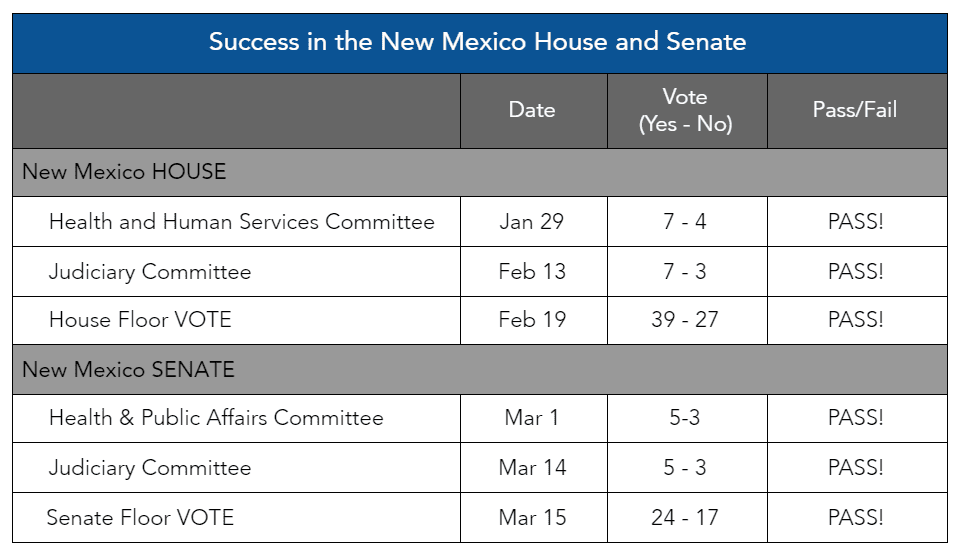
Without question, a key to the success was the amazing bill sponsors, Representative Deborah A. Armstrong (D-Albuquerque) and Senator Elizabeth “Liz” Stefanics (D-Bernalillo), who gave their heart and soul to this effort; the local leaders who served as expert witnesses and brought credibility to the efforts; and the powerful storytellers who put a human face on this issue. The New Mexico End-of-Life Coalition secured volunteers, organizations and partners to secure endorsements from local organizations and resolutions within central municipalities; speak at local events, health fairs and town halls; and put a human face on legislation for communities across the state.
This law is a momentous achievement for New Mexicans. It also represents a chapter for the end-of-life movement. For the first time since the Oregon law was passed in 1994, lawmakers debated the merits of the law, questioning whether it could be improved to ensure more people could access it.
Key Moments Toward the Path Forward
Leading voices in the community, engagement with volunteer advocates and storytellers, and pivotal moments in time over the past five years led to this victory. The collective efforts of our community was overwhelming.
- We lost one of our strongest advocates, Judge Elizabeth Whitefield, in 2018, inspiring our bill sponsors to name the bill after her. The Elizabeth Whitefield End of Life Options Act, sponsored by Representative Deborah Armstrong and Senator Liz Stefanics, was introduced for the 2019 legislative session and is now law in the state of New Mexico.
- Governor Michelle Lujan Grisham expressed her support for the law in 2019:
“We should provide patients with humane end-of-life options, including medical aid in dying for terminally ill capable adults.” — Gov. Michelle Lujan Grisham, 2109
- Compassion & Choices secured the participation of New Mexico native and civil rights icon Dolores Huerta, who advocated throughout the state, recording videos in English and Spanish to urge fellow residents to support the Act.
- The Coalition and Compassion & Choices together were instrumental in passing municipal resolutions of support in three of the state’s largest cities: Albuquerque, Santa Fe and Las Cruces.
- The bill received endorsements from professional medical and advocacy organizations including:
- National Association of Social Workers – NM
- NM Nurse Practitioners Council
- Nuestra Salud
- ACLU-New Mexico
- Health Action New Mexico
- Equality New Mexico
- NAACP – Albuquerque
- NM Transgender Resource Center
- NM Public Health Association
- Many of the major medical societies including the New Mexico Association for Home & Hospice Care, Greater Albuquerque Medical Association, New Mexico Medical Society took positions of engaged neutrality.
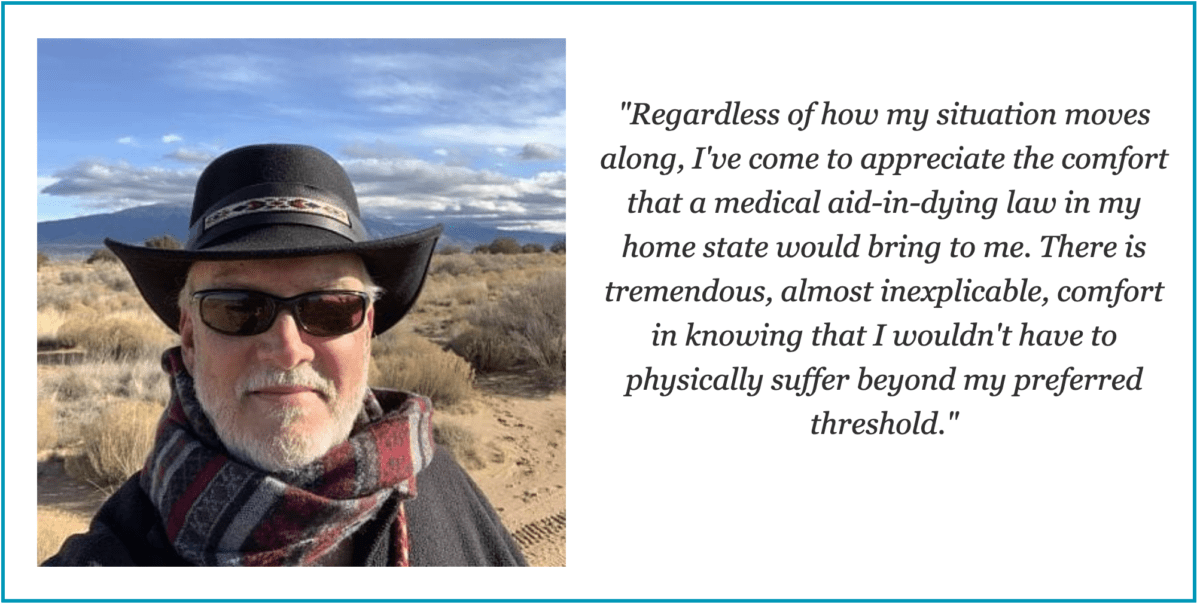
Glenn Buckland, who struggled with plasma cell leukemia, advocated for medical aid in dying in New Mexico. He died one week after the bill passed the Senate floor.
Our victory was possible through a unified effort. Compassion & Choices and the Compassion & Choices Action Network brought forth our strategic and financial resources which includes the powerful grassroots reach of our supporters, volunteers, and storytellers; the New Mexico End-of-Life Options Coalition, which included high-profile and connected leaders and organizations in New Mexico, brought considerable connections, knowledge, local understanding, resilience and hard work to this effort. Together we made history.
On March 1, 2022, End of Life Options New Mexico released their first annual report, retracing the successful legislative journey of the New Mexico Elizabeth Whitefield End-of-Life Options Act and reporting on the exciting beginning of EOLONM's journey of service. You can view the report at EndOfLifeOptionsNM.org.




